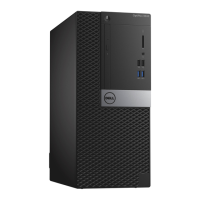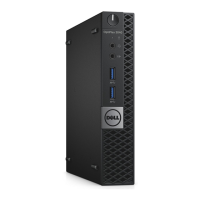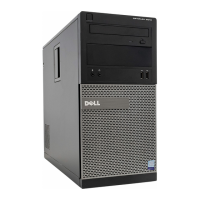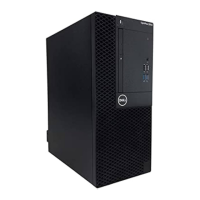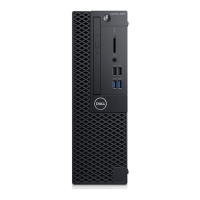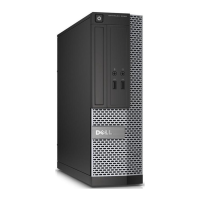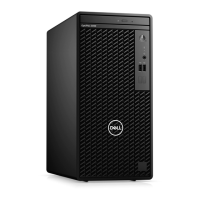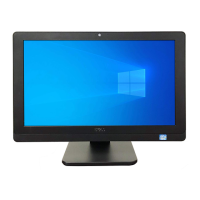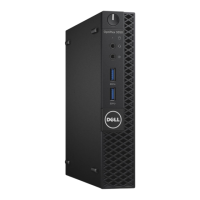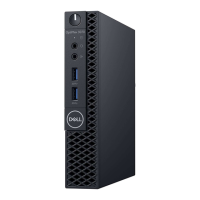Do you have a question about the Dell OptiPlex 3046 and is the answer not in the manual?
Steps to perform before opening the computer to prevent damage and ensure safety.
Procedure to safely power down the computer before maintenance or component replacement.
Steps to reconnect peripherals and power up the computer after maintenance.
List of essential tools required for component removal and installation procedures.
Step-by-step instructions for safely removing the computer's outer cover.
Step-by-step instructions for correctly reinstalling the computer's outer cover.
Procedure to detach the front panel of the computer chassis.
Procedure to attach the front panel of the computer chassis.
Instructions for removing the internal air circulation fan duct.
Instructions for installing the internal air circulation fan duct.
Step-by-step guide to remove RAM modules from the system board.
Step-by-step guide to install RAM modules into the system board.
Procedure to remove the computer chassis intrusion detection switch.
Procedure to install the computer chassis intrusion detection switch.
Steps to remove peripheral expansion cards from the motherboard slots.
Steps to install peripheral expansion cards into the motherboard slots.
Procedure to remove the entire hard disk drive unit.
Instructions to detach the hard drive from its mounting bracket.
Instructions to attach the hard drive to its mounting bracket.
Procedure to install the entire hard disk drive unit into the computer.
Steps to remove the CD/DVD or Blu-ray drive from the computer.
Steps to install the CD/DVD or Blu-ray drive into the computer.
Instructions for removing the internal cooling fan.
Instructions for installing the internal cooling fan.
Procedure to remove the heat sink and fan assembly from the CPU.
Procedure to install the heat sink and fan assembly onto the CPU.
Step-by-step guide to safely remove the CPU from its socket.
Step-by-step guide to safely install the CPU into its socket.
Procedure to remove the optional video graphics adapter board.
Procedure to install the optional video graphics adapter board.
Steps to disconnect and remove the computer's power supply unit.
Steps to connect and install the computer's power supply unit.
Procedure to remove the computer's power button assembly.
Procedure to install the computer's power button assembly.
Steps to remove the integrated SD card reader module.
Steps to install the integrated SD card reader module.
Procedure to disconnect and remove the main computer motherboard.
Procedure to install the main computer motherboard and connect components.
Interpreting power LED status for troubleshooting system issues.
List and description of common system error messages and their causes.
Configuring the order of devices for system startup.
Keys used to navigate and interact within the System Setup utility.
General explanation of the System Setup utility and its functions.
Steps to enter and navigate the System Setup utility.
Overview of general configuration options available in System Setup.
Detailed options for configuring system hardware like NIC, WIDI, and SATA.
Settings for enabling/disabling USB controllers, ports, and PowerShare.
Options to enable or disable the integrated audio controller and microphone.
Options to enable or disable various on-board devices like PCI slot and media card reader.
Options to bypass system and HDD password prompts during restarts.
Controls for the Trusted Platform Module (TPM) visibility and configuration.
Options to enable Secure Boot and manage security key databases.
Enabling Intel Software Guard Extensions for secure code execution.
Option to enable or disable the Intel TurboBoost processor feature.
System response configuration when AC power is reapplied after an outage.
Enabling USB devices to wake the computer from standby mode.
Settings controlling the Power-On Self-Test behavior and boot process speed.
Options for enabling virtual machine monitor support for Intel technologies.
Options for system maintenance tasks like service tag, SERR messages, and BIOS downgrade.
Recommended steps to update the system's BIOS for performance and security.
Configuration settings for cloud desktop software, including server lookup and IP addressing.
Setting system and BIOS passwords to secure the computer.
Detailed steps to create and assign system and setup passwords.
Procedure to remove or modify existing system and setup passwords.
Details on processor type, generation, and cache memory.
Specifications for RAM type, speed, capacity, and connectors.
Information on integrated and discrete graphics adapters.
Details on the integrated audio codec.
Specifications for the integrated network controller.
Information about system chipset, DMA channels, interrupts, and BIOS chip.
Details on bus types and speeds, including PCI Express and SATA.
Specifications for PCI Express expansion card slots.
Information on accessible drive bays and optical drives.
List and specifications of all external ports and connectors.
List and specifications of all internal motherboard connectors.
Details on power connectors for PSU, CPU, and SATA devices.
Description of front and back panel controls and indicator lights.
Information on power supply wattage and heat dissipation.
Specifications for the computer's physical dimensions and weight.
Operating and storage specifications for temperature, humidity, vibration, and altitude.
Steps to perform before opening the computer to prevent damage and ensure safety.
Procedure to safely power down the computer before maintenance or component replacement.
Steps to reconnect peripherals and power up the computer after maintenance.
List of essential tools required for component removal and installation procedures.
Step-by-step instructions for safely removing the computer's outer cover.
Step-by-step instructions for correctly reinstalling the computer's outer cover.
Procedure to detach the front panel of the computer chassis.
Procedure to attach the front panel of the computer chassis.
Instructions for removing the internal air circulation fan duct.
Instructions for installing the internal air circulation fan duct.
Step-by-step guide to remove RAM modules from the system board.
Step-by-step guide to install RAM modules into the system board.
Procedure to remove the computer chassis intrusion detection switch.
Procedure to install the computer chassis intrusion detection switch.
Steps to remove peripheral expansion cards from the motherboard slots.
Steps to install peripheral expansion cards into the motherboard slots.
Procedure to remove the entire hard disk drive unit.
Instructions to detach the hard drive from its mounting bracket.
Instructions to attach the hard drive to its mounting bracket.
Procedure to install the entire hard disk drive unit into the computer.
Steps to remove the CD/DVD or Blu-ray drive from the computer.
Steps to install the CD/DVD or Blu-ray drive into the computer.
Instructions for removing the internal cooling fan.
Instructions for installing the internal cooling fan.
Procedure to remove the heat sink and fan assembly from the CPU.
Procedure to install the heat sink and fan assembly onto the CPU.
Step-by-step guide to safely remove the CPU from its socket.
Step-by-step guide to safely install the CPU into its socket.
Procedure to remove the optional video graphics adapter board.
Procedure to install the optional video graphics adapter board.
Steps to disconnect and remove the computer's power supply unit.
Steps to connect and install the computer's power supply unit.
Procedure to remove the computer's power button assembly.
Procedure to install the computer's power button assembly.
Steps to remove the integrated SD card reader module.
Steps to install the integrated SD card reader module.
Procedure to disconnect and remove the main computer motherboard.
Procedure to install the main computer motherboard and connect components.
Interpreting power LED status for troubleshooting system issues.
List and description of common system error messages and their causes.
Configuring the order of devices for system startup.
Keys used to navigate and interact within the System Setup utility.
General explanation of the System Setup utility and its functions.
Steps to enter and navigate the System Setup utility.
Overview of general configuration options available in System Setup.
Detailed options for configuring system hardware like NIC, WIDI, and SATA.
Settings for enabling/disabling USB controllers, ports, and PowerShare.
Options to enable or disable the integrated audio controller and microphone.
Options to enable or disable various on-board devices like PCI slot and media card reader.
Options to bypass system and HDD password prompts during restarts.
Controls for the Trusted Platform Module (TPM) visibility and configuration.
Options to enable Secure Boot and manage security key databases.
Enabling Intel Software Guard Extensions for secure code execution.
Option to enable or disable the Intel TurboBoost processor feature.
System response configuration when AC power is reapplied after an outage.
Enabling USB devices to wake the computer from standby mode.
Settings controlling the Power-On Self-Test behavior and boot process speed.
Options for enabling virtual machine monitor support for Intel technologies.
Options for system maintenance tasks like service tag, SERR messages, and BIOS downgrade.
Recommended steps to update the system's BIOS for performance and security.
Configuration settings for cloud desktop software, including server lookup and IP addressing.
Setting system and BIOS passwords to secure the computer.
Detailed steps to create and assign system and setup passwords.
Procedure to remove or modify existing system and setup passwords.
Details on processor type, generation, and cache memory.
Specifications for RAM type, speed, capacity, and connectors.
Information on integrated and discrete graphics adapters.
Details on the integrated audio codec.
Specifications for the integrated network controller.
Information about system chipset, DMA channels, interrupts, and BIOS chip.
Details on bus types and speeds, including PCI Express and SATA.
Specifications for PCI Express expansion card slots.
Information on accessible drive bays and optical drives.
List and specifications of all external ports and connectors.
List and specifications of all internal motherboard connectors.
Details on power connectors for PSU, CPU, and SATA devices.
Description of front and back panel controls and indicator lights.
Information on power supply wattage and heat dissipation.
Specifications for the computer's physical dimensions and weight.
Operating and storage specifications for temperature, humidity, vibration, and altitude.
| Tcase | 65 °C |
|---|---|
| Bus type | DMI3 |
| Stepping | S0 |
| FSB Parity | No |
| Processor cache | 3 MB |
| Processor cores | 2 |
| System bus rate | 8 GT/s |
| Processor family | Intel® Core™ i3 |
| Processor series | Intel Core i3-6100 series |
| Processor socket | LGA 1151 (Socket H4) |
| Processor threads | 4 |
| Processor codename | Skylake |
| Processor frequency | 3.7 GHz |
| Processor cache type | L3 |
| Processor lithography | 14 nm |
| Processor manufacturer | Intel |
| Processor front side bus | - MHz |
| PCI Express slots version | 3.0 |
| Processor operating modes | 64-bit |
| ECC supported by processor | Yes |
| PCI Express configurations | 1x16, 1x8+2x4, 2x8 |
| Thermal Design Power (TDP) | 51 W |
| Number of processors installed | 1 |
| Maximum number of PCI Express lanes | 16 |
| Memory types supported by processor | DDR3L-SDRAM, DDR4-SDRAM |
| Memory voltage supported by processor | 1.35 V |
| Memory clock speeds supported by processor | 1333, 1600, 1866, 2133 MHz |
| Memory bandwidth supported by processor (max) | 34.1 GB/s |
| Maximum internal memory supported by processor | 64 GB |
| Memory slots | 2x SO-DIMM |
| Internal memory | 4 GB |
| Memory channels | Dual-channel |
| Memory clock speed | 2133 MHz |
| Internal memory type | DDR4-SDRAM |
| Maximum internal memory | 16 GB |
| Memory layout (slots x size) | 1 x 4 GB |
| HDD speed | 7200 RPM |
| HDD interface | SATA III |
| Storage media | HDD |
| Total storage capacity | 500 GB |
| On-board graphics card ID | 0x1912 |
| Discrete graphics card model | Not available |
| On-board graphics card model | Intel® HD Graphics 530 |
| On-board graphics card family | Intel® HD Graphics |
| Maximum on-board graphics card memory | 1.7 GB |
| On-board graphics card OpenGL version | 4.4 |
| On-board graphics card base frequency | 350 MHz |
| On-board graphics card DirectX version | 12.0 |
| On-board graphics card dynamic frequency (max) | 1050 MHz |
| Number of displays supported (on-board graphics) | 3 |
| Trial software | MS Office |
| Operating system language | Multilingual |
| Cabling technology | 10/100/1000Base-T(X) |
| Ethernet LAN data rates | 10, 100, 1000 Mbit/s |
| HDMI version | 1.4 |
| PS/2 ports quantity | - |
| USB 2.0 ports quantity | USB 2.0 ports have a data transmission speed of 480 Mbps, and are backwards compatible with USB 1.1 ports. You can connect all kinds of peripheral devices to them. |
| USB 3.2 Gen 1 (3.1 Gen 1) Type-C ports quantity | 0 |
| Chassis type | Mini Tower |
| Product color | Black |
| Placement supported | Horizontal/Vertical |
| Cables included | AC |
| Power supply | 240 W |
| Power supply input voltage | 100 - 240 V |
| Power supply input frequency | 50 - 60 Hz |
| Audio chip | Realtek ALC3234 |
| Product type | PC |
| Motherboard chipset | Intel® H110 |
| Password protection type | BIOS, HDD, Supervisor, User |
| Scalability | 1S |
| Processor code | SR2HG |
| Processor ARK ID | 90729 |
| Processor package size | 37.5 x 37.5 mm |
| Supported instruction sets | SSE4.1, SSE4.2 |
| Thermal solution specification | PCG 2015C |
| Intel Secure Key Technology version | 1.00 |
| Intel Stable Image Platform Program (SIPP) version | 0.00 |
| Intel segment tagging | Home Office, Small Business |
| Operating altitude | -15.2 - 3048 m |
| Non-operating altitude | -15.2 - 10668 m |
| Storage temperature (T-T) | -40 - 65 °C |
| Operating temperature (T-T) | 5 - 35 °C |
| Storage relative humidity (H-H) | 5 - 95 % |
| Operating relative humidity (H-H) | 20 - 80 % |
| Certification | CECP, WEEE |
| Sustainability certificates | ENERGY STAR |
| Depth | 274.3 mm |
|---|---|
| Width | 154.9 mm |
| Height | 350.2 mm |
| Weight | 7930 g |
